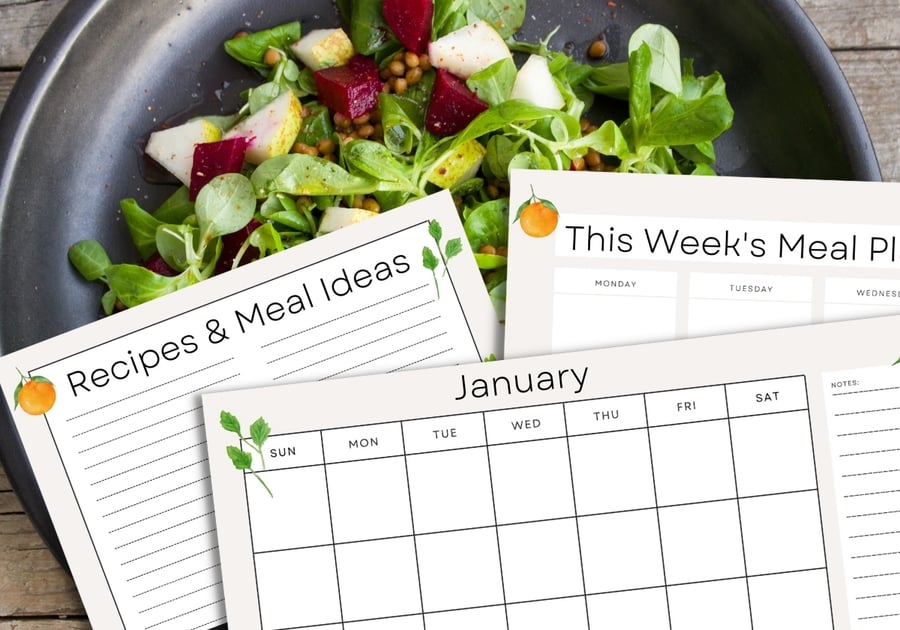I often hear my friends say they want to start meal planning to try to make evenings easier on the whole family, but they struggle with how to even get started with a method they can keep up with.
When I decided to tackle meal planning, I started with just a week or two at a time but found myself going through the same rotation of recipes every few weeks. Boring!
That's when I decided that in order to add some variety, I needed to expand my planning to a full month at a time.
Bonus: I only have to meal plan one day a month instead of one day every week! (People think I like meal planning, but it's not the planning I like — it's the results.)
Through trial and error, I found a system that works well for me. I thought I'd share it with those of you who are trying your hand at meal planning too.
Here's how to create a monthly meal plan that works:
1. Make a meal list
It can be hard to imagine having enough meal ideas to cover the entire month, so start by making a list of things you want to make over the next month — check out my printable meal planning kit for a page to keep those ideas on. Be sure to ask the family what they'd like included.
If you can't come up with enough ideas, now is the time to go through all of your recipe Pins, Macaroni Kid EATS! ideas, your favorite food blogs, and any saved/printed recipes you have stashed away. Remember, you'll need 20 to 30 recipes to cover all the nights you'll be eating at home.
Get your FREE meal planning printables now! |
2. Plan!
Once you have a month of recipes, you can print out, label, and number the blank calendar provided in the meal planning printable pack, or use your family calendar.
I prefer to keep a separate calendar just for meal planning because I do a lot of writing and rewriting as I plan in order to make the most of the ingredients and leftovers. (That's why I highly recommend using a pencil for this step!)
Once I have the whole month planned out, I copy each week's plan onto a separate weekly meal plan page — which is also included in our printable meal planning kit — to hang on my fridge.
How to plan your calendar:
- Note any nights that aren't typical. Think about nights when you'll be away from home, or have other family obligations that necessitate a quick dinner.
- Schedule "easy" meals on days you're in a hurry. Slow cooker recipes are great for busy nights. Same for any meals you simply heat up (or eat cold).
- Don't forget taco Tuesdays! Or meatless Mondays, fish Fridays... you get the idea. If your family likes to have certain meals on certain days, write them down. If you're trying not to repeat a meal, be sure to note variations on the theme.
- Fill in the holes. As you work to fill the remaining days on the calendar, think about shared ingredients that will need to be used up. Also, consider ingredients you can prep on one day and continue to use over the next day or two in order to cut down on your prep time.
3. Stick to the plan!
You know what you're making on Tuesday, so if you need to thaw something out, make sure you leave plenty of time. Don't wait until that afternoon to do it and then decide you don't have time and pitch your plan out the window.
That being said, I highly recommend having meals on hand you can use in a pinch if you do accidentally forget to prep something, or you get held up at work and don't have time to cook... or any other snafu you run into while parenting. I like to keep a pre-cooked meat and a package or two of veggies in the freezer so I can just warm things up quickly on the days life doesn't go according to plan.
One time to consider more flexibility in your calendar? During the local growing season. I like to make the most of fresh fruits and vegetables during Wisconsin's growing season, but what's available changes week to week. Or sometimes an interesting ingredient catches my eye at the farmer's market and I adjust my plan to fit it in.
4. Keep the momentum going
If you get too many complaints from your family about a meal, scratch it off the list.
Also, pay attention to what nights you have leftovers so you can expect them next month. (This is when having a separate calendar comes in handy — you can make notes all over it for next month).
Less waste, more time
Since I started monthly meal planning, I've found we have much less food waste because I'm better about using up leftovers and I'm only buying ingredients I'm planning to use.
Meal planning also makes grocery shopping SO MUCH easier because I just follow my prepared shopping list and I'm not returning to the store to buy something I forgot.
But the best part about a monthly meal plan? I always have an answer to the question: "What's for dinner?"
Laura Miller is the publisher of Macaroni KID Appleton-Waupaca-Oshkosh, Wisc.




